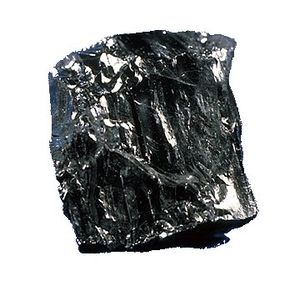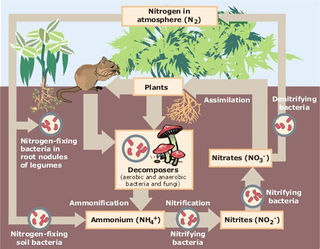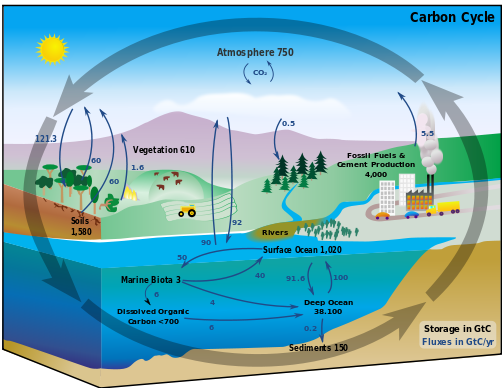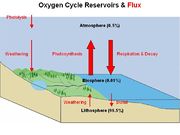Biogeochemical cycle
In ecology and Earth science, a biogeochemical cycle or nutrient cycle is a pathway by which a chemical element or molecule moves through both biotic (biosphere) and abiotic (lithosphere, atmosphere, and hydrosphere) compartments of Earth. In effect, the element is recycled, although in some cycles there may be places (called reservoirs) where the element is accumulated or held for a long period of time (such as an ocean or lake for water). Water, for example, is always recycled through the water cycle, as shown in the diagram. The water undergoes evaporation, condensation, and precipitation, falling back to Earth clean and fresh. Elements, chemical compounds, and other forms of matter are passed from one organism to another and from one part of the biosphere to another through the biogeochemical cycles.[1][2]
Systems
All chemical elements occurring in organisms are part of biogeochemical cycles. In addition to being a part of living organisms, these chemical elements also cycle through abiotic factors of ecosystems such as water (hydrosphere), land (lithosphere), and the air (atmosphere). The living factors of the planet can be referred to collectively as the biosphere. All the nutrients—such as carbon, nitrogen, oxygen, phosphorus, and sulfur—used in ecosystems by living organisms operate on a closed system; therefore, these chemicals are recycled instead of being lost and replenished constantly such as in an open system.[3]
The flow of energy in an ecosystem is an open system; the sun constantly gives the planet energy in the form of light while it is eventually used and lost in the form of heat throughout the trophic levels of a food web. Carbon is used to make carbohydrates, fats, and proteins, the major sources of food energy. These compounds are oxidized to release carbon dioxide, which can be captured by plants to make organic compounds. The chemical reaction is powered by the light energy of the sun.
It is possible for an ecosystem to obtain energy without sunlight. Carbon must be combined with hydrogen and oxygen in order to be utilized as an energy source, and this process depends on sunlight. Ecosystems in the deep sea, where no sunlight can penetrate, use sulfur. Hydrogen sulfide near hydrothermal vents can be utilized by organisms such as the giant tube worm. In the sulfur cycle, sulfur can be forever recycled as a source of energy. Energy can be released through the oxidation and reduction of sulfur compounds (e.g., oxidizing elemental sulfur to sulfite and then to sulfate).
Although the Earth constantly receives energy from the sun, it's chemical composition is essentially fixed, as additional matter is only occasionally added by meteorites. Because this chemical composition is not replenished like energy, all processes that depend on these chemicals must be recycled. These cycles include both the living biosphere and the nonliving lithosphere, atmosphere, and hydrosphere.
Reservoirs
The chemicals are sometimes held for long periods of time in one place. This place is called a reservoir, which, for example, includes such things as coal deposits that are storing carbon for a long period of time.[4] When chemicals are held for only short periods of time, they are being held in exchange pools. Examples of exchange pools include plants and animals.[4] Plants and animals utilize carbon to produce carbohydrates, fats, and proteins, which can then be used to build their internal structures or to obtain energy. Plants and animals temporarily use carbon in their systems and then release it back into the air or surrounding medium. Generally, reservoirs are abiotic factors whereas exchange pools are biotic factors.[5] Carbon is held for a relatively short time in plants and animals in comparison to coal deposits. The amount of time that a chemical is held in one place is called its residence.[4]
Important Cycles
The most well-known and important biogeochemical cycles, for example, include the carbon cycle, the nitrogen cycle, the oxygen cycle, the phosphorus cycle, the sulfur cycle, and the water cycle. There are many biogeochemical cycles that are currently being studied for the first time as climate change and human impacts are drastically changing the speed, intensity, and balance of these relatively unknown cycles. These newly studied biogeochemical cycles include the mercury cycle[6] and the human-caused cycle of atrazine, which may affect certain species.
Biogeochemical cycles always involve equilibrium states: a balance in the cycling of the element between compartments. However, overall balance may involve compartments distributed on a global scale.
As biogeochemical cycles describe the movements of substances on the entire globe, the study of these is inherently multidiciplinary. The carbon cycle may be related to research in ecology and atmospheric sciences.[7] Biochemical dynamics would also be related to the fields of geology and pedology (soil study).[8]
| Global biogeochemical cycles critical for life |
|
|
See also
References
|
Modelling ecosystems - trophic components |
|
| General |
Abiotic component · Abiotic stress · Behaviour · Biogeochemical cycle · Biomass · Biotic component · Biotic stress · Carrying capacity · Competition · Ecosystem · Ecosystem ecology · Ecosystem model · Keystone species · List of feeding behaviours · Metabolic theory of ecology · Productivity
|
 |
|
| Producers |
|
|
| Consumers |
Apex predator · Bacterivore · Carnivores · Chemoorganotroph · Foraging · Generalist and specialist species · Herbivores · Heterotroph · Heterotrophic nutrition · Mesopredator release hypothesis · Omnivores · Optimal foraging theory · Predation
|
|
| Decomposers |
Chemoorganoheterotrophy · Decomposition · Detritivores · Detritus
|
|
| Microorganisms |
Bacteriophage · Lithoautotroph · Lithotrophy · Microbial food web · Microbial loop · Microbial metabolism · Phage ecology
|
|
| Food webs |
Cold seeps · Hydrothermal vents · Intertidal · Kelp forests · Lakes · North Pacific Subtropical Gyre · Rivers · San Francisco Estuary · Soil · Tidal pool
|
|
| Trophic effects |
Ascendency · Bioaccumulation · Biomagnification · Cascade effect · Competitive exclusion principle · Copiotrophs · Dominance · Ecological efficiency · Ecological network · Ecological pyramid · Ecological succession · Energy quality · Energy Systems Language · f-ratio · Feed conversion ratio · Feeding frenzy · Mesotrophic soil · Oligotroph · Paradox of the plankton · Trophic cascade · Trophic level · Trophic mutualism · Trophic state index
|
|
| Defense/counter |
Antipredator adaptations · Herbivore adaptations to plant defense · Plant defense against herbivores · Predator avoidance in schooling fish
|
|
|
|
|
Modelling ecosystems - other components |
|
| Population ecology |
Abundance · Allee effect · Depensation · Ecological yield · Effective population size · Intraspecific competition · Logistic function · Malthusian growth model · Maximum sustainable yield · Overpopulation in wild animals · Overexploitation · Population cycle · Population dynamics · Population modeling · Population size · Predator–prey equations · Recruitment · Resilience · Small population size · Stability
|
 |
|
| Species |
Biodiversity · Density-dependent inhibition · Ecological effects of biodiversity · Ecological extinction · Endemic species · Flagship species · Gradient analysis · Indicator species · Introduced species · Invasive species · Latitudinal gradients in species diversity · Minimum viable population · Occupancy-abundance relationship · Population viability analysis · Rapoport's rule · Relative abundance distribution · Relative species abundance · Species diversity · Species homogeneity · Species richness · Species distribution · Species-area curve · Umbrella species
|
|
| Species interaction |
|
|
| Spatial ecology |
Cross-boundary subsidy · Ecocline · Ecotone · Ecotype · Disturbance · Edge effect · Foster's rule · Habitat fragmentation · Intermediate Disturbance Hypothesis · Island biogeography · Landscape ecology · Landscape epidemiology · Landscape limnology · Metapopulation · Patch dynamics · Source–sink dynamics
|
|
| Niche |
Ecological niche · Ecological trap · Ecosystem engineer · Environmental niche modelling · Guild · Habitat · Limiting similarity · Niche apportionment models · Niche differentiation
|
|
| Other networks |
Assembly rules · Bateman's principle · Bioluminescence · Ecological collapse · Ecological debt · Ecological deficit · Ecological energetics · Ecological indicator · Ecological threshold · Ecosystem diversity · Emergence · Kleiber's law · Liebig's law of the minimum · Marginal value theorem · Thorson's rule · Xerosere
|
|
| Other |
Allometry · Alternative stable state · Balance of Nature · Biological data visualization · Biogeography · Constructal theory · Ecocline · Ecological economics · Ecological footprint · Ecological forecasting · Ecological humanities · Ecological stoichiometry · Ecopath · Ecosystem based fisheries · Endolith · Evolutionary ecology · Functional ecology · Industrial ecology · Macroecology · Microecosystem · Natural environment · Systems ecology · Theoretical ecology
|
|
| List of ecology topics |
|
|
|







